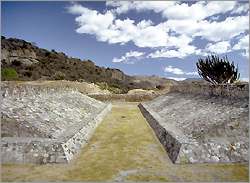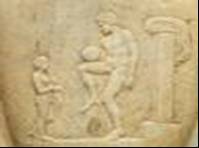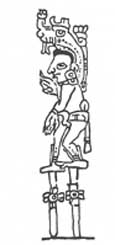
According to the socio-historical facts and data, we
find that some kind of ball game has been unknown for at least 3000
years now. The earliest evidence of football was found in Kyoto, Japan.
Another document shows that the Chinese army were playing a game that
involved kicking a ball into a small net. There is also evidence that a
ball game, very similar to football, was played by the
ancient Greeks
Going back in the history of football everyone will discover its origin again. The first games including a ball, appeared in Greece during the Era of Homerous. A fact that proves the greeks roots of football is a tomb monument of an athlete "playing" with a ball in Athens. Palaistra and Episkyros are names which were given to ball games in Greece despite the fact they are more similar to wrestling and rugby. Moreover Julius Pollux from Egypt, a teacher of rhetoric and oratory who was interested in Greece, included information of ball games in his books. Another Greek name for such games is Harpaston, which was later renamed in Harpastum by Romans who, after additions, introduced ancient football. Finally another evidence for the Greek origin of football is a statue of Kouros and another athlete representing not only football,but volleyball as well.


Pok-a-tok was an ancient Mayan ball game which was played in fields at the size of football's ones. They had two opposing walls 26 feet high and at about 23 feet, there was a hoop which was placed vertically to the ground. There were two teams of seven players each. The equipment they had was similar to their hunters'. They wore leather gloves, chin pieces, cotton elbowpads, knee pads, belts and a leather apron. The aim of the game was to get a small rubber ball to go through the hoop without using their hands or feet. It is said that the players of the team that had lost were sacrificed to the gods. But it must have been something very usual because archeologists have found either ruins or entire well-preserved fields in every Mayan city they came across. Particularly in Chitchen Itza there are 23 courts, one of them 545 feet long and 225 feet wide.

At around 2000BC, the Greeks discovered a ball game known as Episkyros which involved two teams of equal numbers. Between them a white line was laid out, and, at some distance behind each team, another line was marked. The first balls were made of linen and hair wrapped in string and sewn together. But, since the balls weren't very good, they developed them into balls from inflated pig bladers wrapped tight in leather. The play consisted in throwing the ball back and forth until one team in the exchange was finally forced back over its rear line.
Phaininda was another ancient Greek game. The players made a circle and threw the ball to each other. Its name comes from the greek word "fainomai" which meant "to feint" that one player was going to throw the ball to a second player but threw it to a third player instead.


Οι σελίδα δημιουργήθηκε με υλικό από εργασία σε Power Point που έγινε στο πλαίσιο του μαθήματος της Αγγλικής Γλώσσας με την καθοδήγηση και εποπτεία της καθηγήτριας Αγγλικών Βασιλειάδου Ευριάνθης.
Η ιστοσελίδα κατασκευάσθηκε από την καθηγήτρια πληροφορικής Αγγελική Μαζαράκη.

